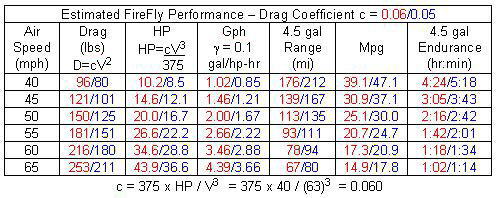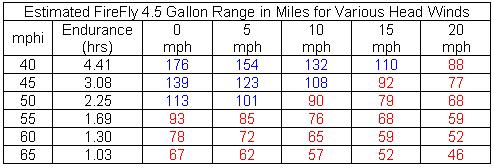|
|
 The topic of best cruise speed came up on the Kolb List, and it made me curious as to what can one really expect for the FireFly? By using the drag and horsepower equations from the Parasite Resistance, Struts And Wires page, I lumped the kDL term into a new coefficient c. Then using the new equation, I solved for c. Since the FireFly was designed to meet 103-7, I used 63 mph for air speed and 40 hp for the engine.
The topic of best cruise speed came up on the Kolb List, and it made me curious as to what can one really expect for the FireFly? By using the drag and horsepower equations from the Parasite Resistance, Struts And Wires page, I lumped the kDL term into a new coefficient c. Then using the new equation, I solved for c. Since the FireFly was designed to meet 103-7, I used 63 mph for air speed and 40 hp for the engine.
Next I computed the drag and hp columns for c=0.06. To find fuel consumption rates, I had to assume some specific fuel rate. I picked 0.1 because it seemed reasonable for 50 mph and it made for fewer calculations. Based on these assumptions, the rest of the table was calculated and filled in in red. After this was done I cleaned up the FireFly and moved it more toward a Thunder Gull 2000 by reducing c from 0.06 to 0.05. The results are shown in blue. These calculations do not take into account engine and propeller efficiencies, etc. but the results can be used to generalize FireFly performance.
If you cruise at lower speed,
While keeping the FireFly legal, anything you can do to reduce drag will improve all of the above. If you like to fly one hundred mile legs. Calculating flight times at various speeds will give the following results.
.mph................hr:min On the last three flights, one would have to stop for fuel and so 30 minutes was added to accommodate refueling. Assuming no head wind, this indicates a 50 mph cruise would give the quickest time point to point.
Response to Questions and/or Comments Yes, you can adapt it to suit your own aircraft. To find the drag coefficient c, use your top speed and maximum engine hp. This will let you calculate the drag and hp columns. The specific fuel consumption is a little tougher. When I looked at the hp values and saw 20 hp at 50 mph, I realized that 0.1 would be a good choice for me because the FireFly typically cruises at 2.0 or less at 50 mph. In your case, surely you have flown your plane enough to know with some accuracy the gph rate at your favorite cruise speed. Compute the hp required to fly at that speed. Then divide your gph by the hp you computed to get your specific fuel rate. Using this number multiply it against all of the other hps to fill in the gph column. For the range column, identify your useable fuel volume. Divide this volume by gph and multiply by the air speed to find the range. Mpg is the range divided by useable fuel volume. Endurance is the maximum useable fuel divided by the gph.
 Yes you are correct, the calculations were all done without considering head
or tail winds. This can easily be accommodated by using ground speed during
the calculations for range. Endurance will not change.
Yes you are correct, the calculations were all done without considering head
or tail winds. This can easily be accommodated by using ground speed during
the calculations for range. Endurance will not change.
Above is the estimated range for a given indicated air speed minus the head wind. The endurance column is show in hours only. |